-
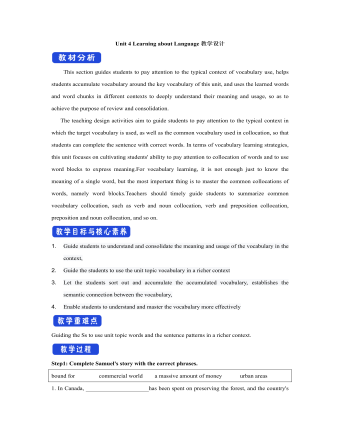
新人教版高中英语选修2Unit 4 Learning about Language教学设计
This section guides students to pay attention to the typical context of vocabulary use, helps students accumulate vocabulary around the key vocabulary of this unit, and uses the learned words and word chunks in different contexts to deeply understand their meaning and usage, so as to achieve the purpose of review and consolidation.The teaching design activities aim to guide students to pay attention to the typical context in which the target vocabulary is used, as well as the common vocabulary used in collocation, so that students can complete the sentence with correct words. In terms of vocabulary learning strategies, this unit focuses on cultivating students' ability to pay attention to collocation of words and to use word blocks to express meaning.For vocabulary learning, it is not enough just to know the meaning of a single word, but the most important thing is to master the common collocations of words, namely word blocks.Teachers should timely guide students to summarize common vocabulary collocation, such as verb and noun collocation, verb and preposition collocation, preposition and noun collocation, and so on.1. Guide students to understand and consolidate the meaning and usage of the vocabulary in the context, 2. Guide the students to use the unit topic vocabulary in a richer context3. Let the students sort out and accumulate the accumulated vocabulary, establishes the semantic connection between the vocabulary,4. Enable students to understand and master the vocabulary more effectivelyGuiding the Ss to use unit topic words and the sentence patterns in a richer context.
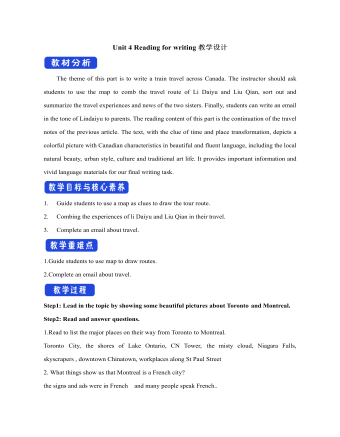
新人教版高中英语选修2Unit 4 Reading for writing教学设计
假定你是英国的Jack,打算来中国旅行,请你给你的中国笔友李华写一封信,要点如下:1.你的旅行计划:北京→泰山→杭州;2.征求建议并询问他是否愿意充当你的导游。注意:1.词数80左右(开头和结尾已给出,不计入总词数);2.可以适当增加细节,以使行文连贯。参考词汇:故宫 the Forbidden City;泰山 Mount TaiDear Li Hua,I'm glad to tell you that 'm going to visit China.First,I am planning to visit Beijing,the capitalof China,where I am looking forward to enjoying the Great Wall,the Forbidden City and somebeautiful parks.Then I intend to go to visit Mount Tai in Shandong Province.I've heard that it is one ofthe most famous mountains in China and I can't wait to enjoy the amazing sunrise there.After that,I amalso going to Hangzhou.It is said that it is a beautiful modern city with breathtaking natural sights,among which the West Lake is a well- known tourist attraction.What do you think of my travel plan? Will you act as my guide? Hope to hear from you soon.

新人教版高中英语选修2Unit 4 Using langauge-Listening教学设计
The theme of the listening section is " talking about scenery and culture along a journey."The part is designed to further lead the students to understand Canadian natural geography and social environment, and integrated into the cultural contrast by mentioning the long train journey from Beijing to Moscow routes. On this basis, the part activates students related travel experience, lets the student serial dialogue, guides the student to explore further the pleasure and meaning of the long journey, and Chinese and foreign cultural comparison.The part also provides a framework for the continuation of the dialogue, which is designed to provide a framework for students to successfully complete their oral expressions, and to incorporate an important trading strategy to end the dialogue naturally.1. Help students to understand and master some common English idioms in the context, and experience the expression effect of English idioms.2. Guide the students to understand the identity of different people in the listening context, and finish the dialogue according to their own experience.3. Instruct the students to use appropriate language to express surprise and curiosity about space and place in the dialogue, and master the oral strategy of ending the dialogue naturally.1. Instruct students to grasp the key information and important details of the dialogue.2. Instruct students to conduct a similar talk on the relevant topic.

新人教版高中英语选修2Unit 5 Learning about Language教学设计
The purpose of this section of vocabulary exercises is to consolidate the key words in the first part of the reading text, let the students write the words according to the English definition, and focus on the detection of the meaning and spelling of the new words. The teaching design includes use English definition to explain words, which is conducive to improving students' interest in vocabulary learning, cultivating their sense of English language and thinking in English, and making students willing to use this method to better grasp the meaning of words, expand their vocabulary, and improve their ability of vocabulary application. Besides, the design offers more context including sentences and short passage for students to practice words flexibly.1. Guide students to understand and consolidate the meaning and usage of the vocabulary in the context, 2. Guide the students to use the unit topic vocabulary in a richer context3. Let the students sort out and accumulate the accumulated vocabulary, establishes the semantic connection between the vocabulary,4. Enable students to understand and master the vocabulary more effectivelyGuiding the Ss to use unit topic words and the sentence patterns in a richer context.Step1: Read the passage about chemical burns and fill in the blanks with the correct forms of the words in the box.
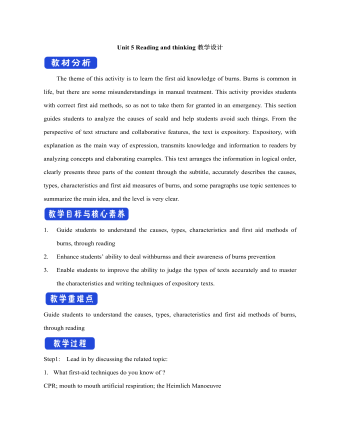
新人教版高中英语选修2Unit 5 Reading and thinking教学设计
The theme of this activity is to learn the first aid knowledge of burns. Burns is common in life, but there are some misunderstandings in manual treatment. This activity provides students with correct first aid methods, so as not to take them for granted in an emergency. This section guides students to analyze the causes of scald and help students avoid such things. From the perspective of text structure and collaborative features, the text is expository. Expository, with explanation as the main way of expression, transmits knowledge and information to readers by analyzing concepts and elaborating examples. This text arranges the information in logical order, clearly presents three parts of the content through the subtitle, accurately describes the causes, types, characteristics and first aid measures of burns, and some paragraphs use topic sentences to summarize the main idea, and the level is very clear.1. Guide students to understand the causes, types, characteristics and first aid methods of burns, through reading2. Enhance students’ ability to deal withburnss and their awareness of burns prevention3. Enable students to improve the ability to judge the types of texts accurately and to master the characteristics and writing techniques of expository texts.Guide students to understand the causes, types, characteristics and first aid methods of burns, through readingStep1: Lead in by discussing the related topic:1. What first-aid techniques do you know of ?CPR; mouth to mouth artificial respiration; the Heimlich Manoeuvre

新人教版高中英语选修2Unit 5 Using langauge-Listening教学设计
The theme of this section is to learn how to make emergency calls. Students should learn how to make emergency calls not only in China, but also in foreign countries in English, so that they can be prepared for future situations outside the home.The emergency telephone number is a vital hotline, which should be the most clear, rapid and effective communication with the acute operator.This section helps students to understand the emergency calls in some countries and the precautions for making emergency calls. Through the study of this section, students can accumulate common expressions and sentence patterns in this context. 1.Help students accumulate emergency telephone numbers in different countries and learn more about first aid2.Guide the students to understand the contents and instructions of the telephone, grasp the characteristics of the emergency telephone and the requirements of the emergency telephone.3.Guide students to understand the first aid instructions of the operators.4.Enable Ss to make simulated emergency calls with their partners in the language they have learned1. Instruct students to grasp the key information and important details of the dialogue.2. Instruct students to conduct a similar talk on the relevant topic.Step1:Look and discuss:Match the pictures below to the medical emergencies, and then discuss the questions in groups.
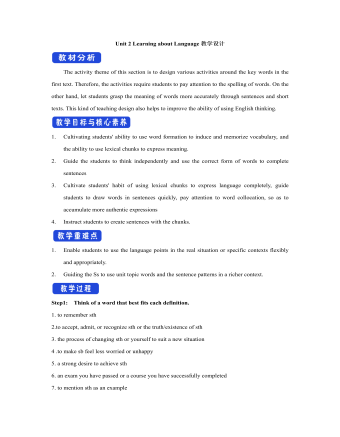
新人教版高中英语选修2Unit 2 Learning about Language教学设计
The activity theme of this section is to design various activities around the key words in the first text. Therefore, the activities require students to pay attention to the spelling of words. On the other hand, let students grasp the meaning of words more accurately through sentences and short texts. This kind of teaching design also helps to improve the ability of using English thinking.1. Cultivating students' ability to use word formation to induce and memorize vocabulary, and the ability to use lexical chunks to express meaning.2. Guide the students to think independently and use the correct form of words to complete sentences3. Cultivate students' habit of using lexical chunks to express language completely, guide students to draw words in sentences quickly, pay attention to word collocation, so as to accumulate more authentic expressions4. Instruct students to create sentences with the chunks.1. Enable students to use the language points in the real situation or specific contexts flexibly and appropriately.2. Guiding the Ss to use unit topic words and the sentence patterns in a richer context.Step1: Think of a word that best fits each definition.1. to remember sth2.to accept, admit, or recognize sth or the truth/existence of sth3. the process of changing sth or yourself to suit a new situation4 .to make sb feel less worried or unhappy5. a strong desire to achieve sth
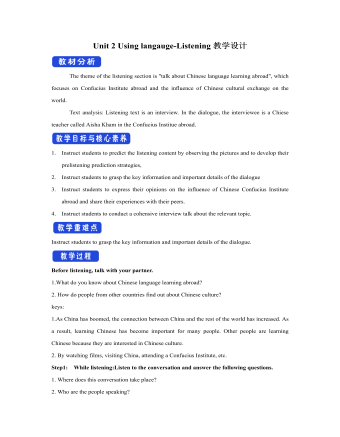
新人教版高中英语选修2Unit 2 Using langauge-Listening教学设计
? B: Absolutely! Getting involved with Chinese cultural activities there definitely helped a lot. I got to practice my Chinese on a daily basis, and I could learn how native Chinese speakers spoke.? A: What do you feel is your biggest achievement?? B: Learning Chinese characters! I have learnt about 1,500 so far. When I first started, I didn't think it was even going to be possible to learn so many, but now I find that I can read signs, menus, and even some easy newspaper articles.? A: What are you most keen on?? B: I've really become keen on learning more about the Chinese culture, in particular Chinese calligraphy. As I have learnt Chinese characters, I have developed a great appreciation for their meaning. I want to explore Chinese characters by learning how to write them in a more beautiful way. ? A: Finally, what do you want to say to anyone interested in learning Chinese?? I have really become keen on learning more about the Chinese culture, in particular Chinese Calligraphy. As I have learnt Chinese character, I have developed a great appreciation for their meaning. I want to explore Chinese characters by learning how to write them in a more beautiful way.? A: Finally, what do you want to say to anyone interested in learning Chinese?? B: I'd say, give it a shot! While some aspects may be difficult, it is quite rewarding and you will be happy that you tried.? A: Thanks for your time. ? B:You're welcome.
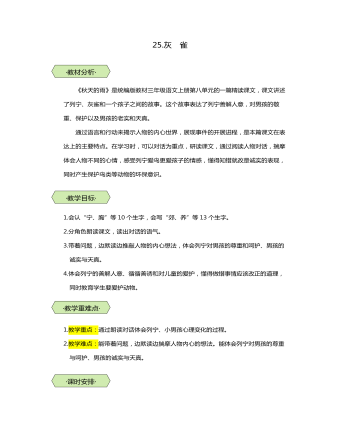
统编版三年级语文上第25课灰雀教学设计教案
《秋天的雨》是统编版教材三年级语文上册第八单元的一篇精读课文,课文讲述了列宁、灰雀和一个孩子之间的故事。这个故事表达了列宁善解人意,对男孩的敬重、保护以及男孩的老实和天真。通过语言和行动来揭示人物的内心世界,展现事件的开展进程,是本篇课文在表达上的主要特点。在学习时,可以对话为重点,研读课文,通过阅读人物对话,揣摩体会人物不同的心情,感受列宁爱鸟更爱孩子的情感,懂得知错就改是诚实的表现,同时产生保护鸟类等动物的环保意识。 1.会认“宁、胸”等10个生字,会写“郊、养”等13个生字。2.分角色朗读课文,读出对话的语气。3.带着问题,边默读边推敲人物的内心想法,体会列宁对男孩的尊重和呵护、男孩的诚实与天真。4.体会列宁的善解人意、循循善诱和对儿童的爱护,懂得做错事情应该改正的道理,同时教育学生要爱护动物。 1.教学重点:通过朗读对话体会列宁、小男孩心理变化的过程。2.教学难点:能带着问题,边默读边揣摩人物内心的想法。能体会列宁对男孩的尊重与呵护、男孩的诚实与天真。 2课时
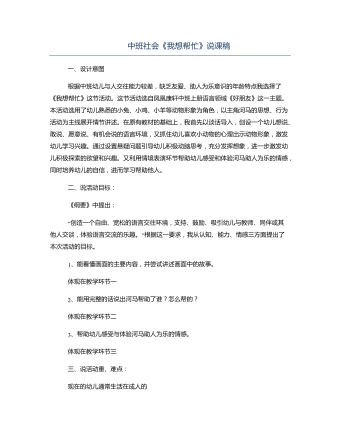
中班社会《我想帮忙》说课稿
根据中班幼儿与人交往能力较差,缺乏友爱、助人为乐意识的年龄特点我选择了《我想帮忙》这节活动。这节活动选自凤凰康轩中班上册语言领域《好朋友》这一主题。本活动选用了幼儿熟悉的小兔、小鸡、小羊等动物形象为角色,以主角河马的思想、行为活动为主线展开情节讲述。在原有教材的基础上,我首先以谈话导入,创设一个幼儿想说、敢说、愿意说、有机会说的语言环境,又抓住幼儿喜欢小动物的心理出示动物形象,激发幼儿学习兴趣。通过设置悬疑问题引导幼儿积极动脑思考,充分发挥想象,进一步激发幼儿积极探索的欲望和兴趣。又利用情境表演环节帮助幼儿感受和体验河马助人为乐的情感,同时培养幼儿的自信,进而学习帮助他人。
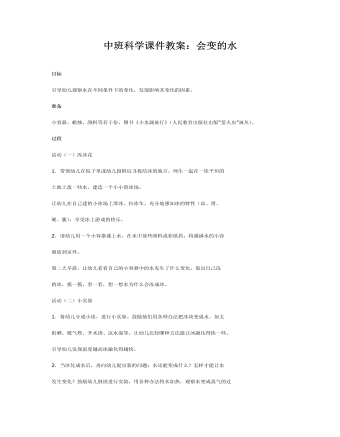
中班科学课件教案:会变的水
准备小容器、蜡烛、颜料等若干份,图书《小水滴旅行》(人民教育出版社出版“萤火虫”画丛)。过程活动(一)冻冰花1.带领幼儿在院子里或幼儿园附近寻找结冰的地方。师生一起在一块平坦的土地上泼一些水,建造一个小小滑冰场。让幼儿在自己建的小冰场上滑冰、拉冰车,充分地感知冰的特性(凉、滑、硬、脆),享受冰上游戏的快乐。中循环
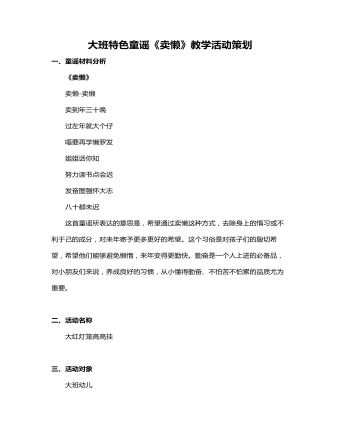
《卖懒》教学设计教案
1.制作红灯笼师:(展示漂亮的灯笼)小朋友们想不想自己亲手制作一个呢?生:好呀师:那小朋友们知道制作灯笼需要什么材料吗?生:彩纸、剪刀...师:没错,那老师先来展示一下怎么制作灯笼吧!(展示完后,开始让小朋友两两组合共同制作)2.制作灯笼剪纸师:小朋友们,刚刚是不是已经制作灯笼了呀?下面我们进行一个更好玩的环节?生:好呀好呀!师:那我先来展示一下咯,小朋友们别眨眼呀!(展示完后,开始让小朋友们独立完成)小结:通过制作共同合作制作灯笼与独自完成灯笼剪影,不仅使他们更能感知灯笼的形状,更能提高小朋友们的动手能力和思考力。
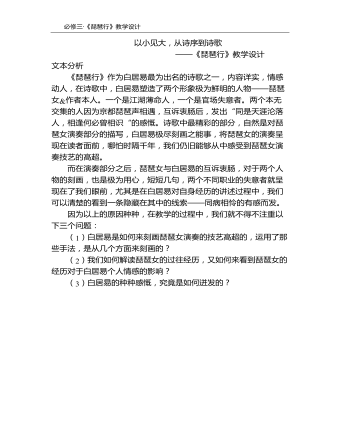
《琵琶行》教学设计
文本分析《琵琶行》作为白居易最为出名的诗歌之一,内容详实,情感动人,在诗歌中,白居易塑造了两个形象极为鲜明的人物——琵琶女&作者本人。一个是江湖薄命人,一个是官场失意者。两个本无交集的人因为京都琵琶声相遇,互诉衷肠后,发出“同是天涯沦落人,相逢何必曾相识“的感慨
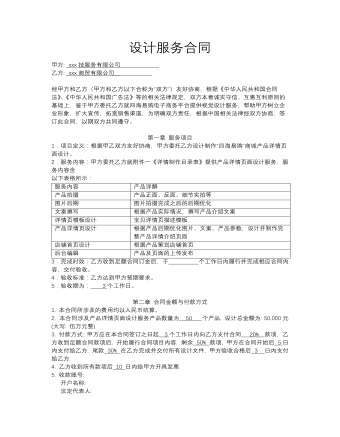
设计服务合同
甲方: _xxx技服务有限公司 乙方: _xxx商贸有限公司__ 经甲方和乙方(甲方和乙方以下合称为“双方”)友好协商,根据《中华人民共和国合同法》、《中华人民共和国广告法》等的相关法律规定,双方本着诚实守信、互惠互利原则的基础上,鉴于甲方委托乙方就四海易购电子商务平台提供视觉设计服务,帮助甲方树立企业形象,扩大宣传,拓宽销售渠道,为明确双方责任,根据中国相关法律经双方协商,签订此合同,以期双方共同遵守。第一章 服务项目1.项目定义:根据甲乙双方友好协商,甲方委托乙方设计制作“四海易购”商城产品详情页面设计。2.服务内容:甲方委托乙方就附件一《详情制作目录表》提供产品详情页面设计服务,服务内容含以下表格所示:服务内容 产品详解产品拍摄 产品正面、反面、细节实拍等图片后期 图片拍摄完成之后的后期优化文案撰写 根据产品实际情况,撰写产品介绍文案详情页模板设计 宝贝详情页描述模板产品详情页设计 根据产品后期优化图片、文案、产品参数,设计并制作完整产品详情介绍页面店铺首页设计 根据产品策划店铺首页后台编辑 产品及页面的上传发布
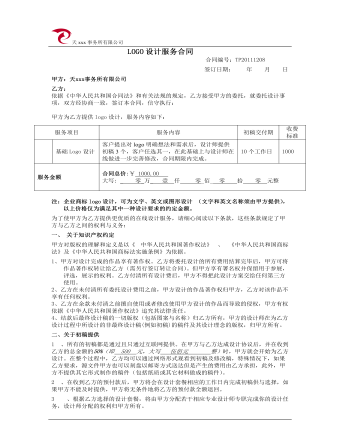
LOGO设计服务合同
甲方:天xxx事务所有限公司乙方:依据《中华人民共和国合同法》和有关法规的规定,乙方接受甲方的委托,就委托设计事项,双方经协商一致,签订本合同,信守执行:甲方为乙方提供logo设计,服务内容如下:服务项目 服务内容 初稿交付期 收费标准基础Logo设计 客户提出对logo明确想法和需求后,设计师提供初稿3个,客户任选其一,在此基础上与设计师在线做进一步完善修改,合同期限内完成。 10个工作日 1000服务金额 合同总价:¥ 1000.00 大写: _ 零_万_ 壹 仟 零_佰_ 零 拾 零 元整 注:企业商标logo设计,可为文字、英文或图形设计 (文字和英文名称须由甲方提供),以上价格仅为满足其中一种设计要求的约定金额。为了使甲方为乙方提供更优质的在线设计服务,请细心阅读以下条款,这些条款规定了甲方与乙方之间的权利与义务:一、 关于知识产权约定甲方对版权的理解和定义是以《 中华人民共和国著作权法》 、 《中华人民共和国商标法》及《中华人民共和国商标法实施条例》为依据。 1、甲方对设计完成的作品享有著作权。乙方将委托设计的所有费用结算完毕后,甲方可将作品著作权转让给乙方(需另行签订转让合同)。但甲方享有署名权并保留用于参展,评选,展示的权利。乙方付清所有设计费后,甲方不得把此设计方案交给任何第三方使用。2、乙方在未付清所有委托设计费用之前,甲方设计的作品著作权归甲方,乙方对该作品不享有任何权利。

LOGO设计委托书
依据《中华人民共和国合同法》和有关法规的规定,乙方接受甲方的委托,就委托设计事项,双方经协商一致,签订本合同,信守执行:一、合同内容和要求:_______________________________公司标志设计;二、费用:费用共计人民币¥_________元(大写:__________________)三、付款方式1.本合同签订后,甲方即向乙方支付合同总费用50%,即人民币¥_________元整;2.LOGO设计完成;甲方需向乙方支付合同余款,即人民币¥_________元整四、双方的责任与义务.1.乙方应按甲方要求按质按量完成相关设计工作。2.乙方需在规定时间______年_____月_____日至______年_____月_____日完成甲方公 司LOGO设计工作3.甲方有责任全力配合乙方开展本合同所规定的工作,并根据乙方需要提供相关资料。五、知识产权约定1.乙方对设计完成的作品享有著作权。甲方将委托设计的所有费用结算完毕后,乙方 可将作品著作权转让给甲方。2.甲方在未付清所有委托设计费用之前,乙方设计的作品著作权归乙方,甲方对该作品不享有任何权利。3.甲方在余款未付清之前擅自使用或者修改使用乙方设计的作品而导致的侵权,乙方有权依据《中华人民共和国著作权法》追究其法律责任。
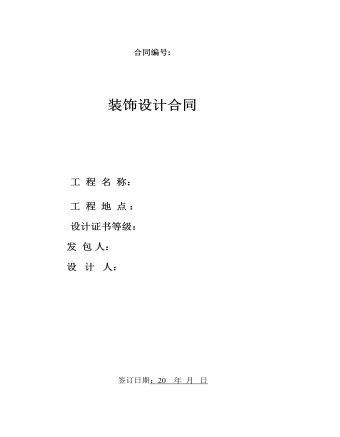
装饰设计合同
发包人委托设计人承担装修室内工程设计,经双方协商一致,签订本协议。第一条 本合同依据下列文件签订:1.1《中华人民共和国合同法》《建设工程勘察设计市场管理规定》。1.2国家地方有关建设工程勘察设计管理法规和规章。1.3建设工程批准文件。序号 分工程名称 建设规模 设计阶段及内容 估算总投资<万元) 费率% 设计费<万元)层数 建筑面积<m2) 公用部分 室内部分 施工图 1 合计 说明 1. 本设计不包括园林、厨房和智能化设计。2. 本设计不负责建报图和竣工图。第二条 本合同设计工程的内容:名称、规模、阶段、投资及设计费等见下表。
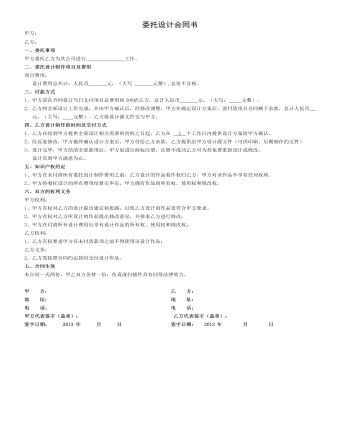
委托设计合同书
一、委托事项甲方委托乙方为其公司进行 工作。 二、委托设计制作项目及费用项目费用:设计费用总共计:人民币 元,(大写 元整),总价不含税。 三、付款方式1、甲方需在合同签订当日支付项目总费用的50%给乙方,总计人民币 元,(大写: 元整)。2、乙方将全部设计工作完成,并由甲方确认后,经修改调整,甲方在确定设计方案后,需付清项目合同剩下余款,总计人民币 元,(大写: 元整)。乙方将设计源文件交与甲方。四、乙方设计制作的时间及交付方式1、乙方在收到甲方提供全部设计相关需要的资料之日起,乙方在 5 个工作日内提供设计方案给甲方确认。2、经反复修改,甲方最终确认设计方案后,甲方付给乙方余款,乙方提供给甲方设计源文件(可供印刷、后期制作的文件)3、设计完毕,甲方结清全部款项后,甲方如进行商标注册,注册不成功乙方可为其免费重新设计或修改。设计直到甲方满意为止。
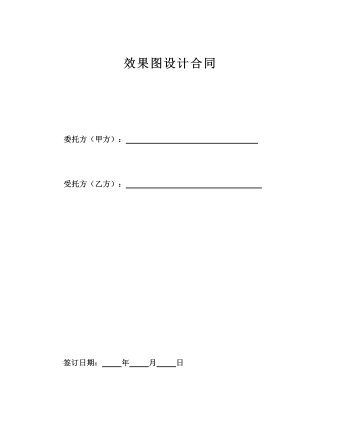
效果图设计合同
根据《中华人民共和国广告法》,《中华人民共和国合同法》及国家有关法律、法规的规定,甲、乙双方在平等、自愿、等价有偿、公平、诚实信用的基础上,经友好协商,就甲方委托乙方设计、制作效果图事宜,达成一致意见,特签订本合同,以资信守。第一条 委托事项委托项目 数量(张) 单价(元/张) 分项总价(元)第二条 合同总价款及付款方式本合同设计费共计人民币 元(大写: ),输出打样等其他费用为人民币 元(大写: ),总价款为人民币 元(大写: )。前述费用已不包括税费,如有需要增加新角度,则在补充合同上另行商定。第三条 双方义务1、甲方负责在约定的时间内提供乙方设计所需的项目资料,并对其所提供的资料的合法性负责。2、甲方应按合同约定向乙方支付本合同价款。3、乙方应在 年 月 日前完成本合同约定的委托事项。4、在制作期间内,甲方发生设计方案变更,或要求修改已确认的效果图制作方案,且乙方已按原方案制作的,甲方应书面确认,并追加费用及时间。5、同一设计稿件若用于不同场合,甲方只付一次设计费。6、乙方设计的效果图应符合相关法律法规的规定,并不得侵犯他人的著作权和其它合法权益。第四条 违约责任1、甲方未能按合同约定付款的,甲方应承担违约责任。每逾期一日,甲方按合同总价款的0.1‰向乙方支付违约金。
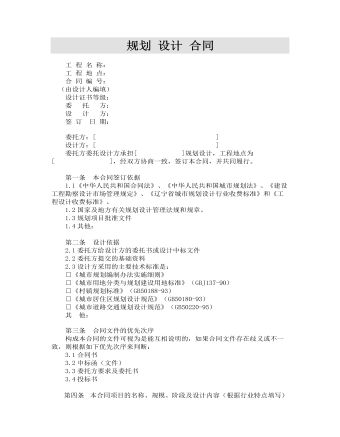
规划 设计 合同
第一条 本合同签订依据1.1《中华人民共和国合同法》、《中华人民共和国城市规划法》、《建设工程勘察设计市场管理规定》、《辽宁省城市规划设计行业收费标准》和《工程设计收费标准》。1.2国家及地方有关规划设计管理法规和规章。1.3规划项目批准文件1.4其他:第二条 设计依据2.1委托方给设计方的委托书或设计中标文件2.2委托方提交的基础资料2.3设计方采用的主要技术标准是:□《城市规划编制办法实施细则》□《城市用地分类与规划建设用地标准》(GBJ137-90)□《村镇规划标准》(GB50188-93)□《城市居住区规划设计规范》(GB50180-93)□《城市道路交通规划设计规范》(GB50220-95)其 他:第三条 合同文件的优先次序构成本合同的文件可视为是能互相说明的,如果合同文件存在歧义或不一致,则根据如下优先次序来判断:3.1合同书3.2中标函(文件)3.3委托方要求及委托书3.4投标书第四条 本合同项目的名称、规模、阶段及设计内容(根据行业特点填写)名 称 :规 模 :□ 用地 □ 人口 □ 其他阶 段 :□ 区域规划 □ 总体规划 □ 分区规划 □ 控制性详细规划 □ 修建性详细规划 □ 专项规划 □ 其他设计内容: